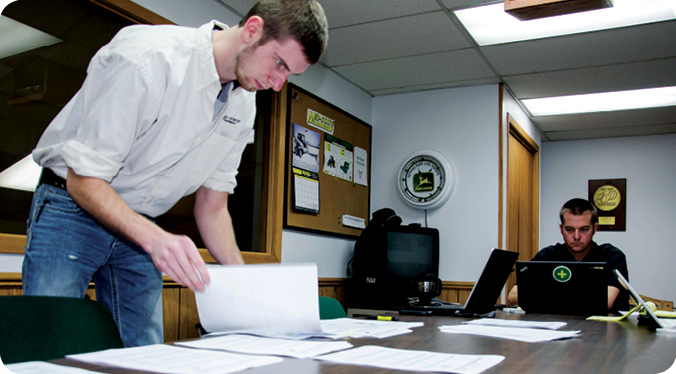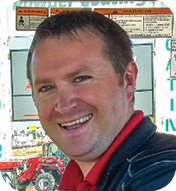When a dealership starts shifting its precision focus from hardware toward data management and agronomics, a few important questions leap out. How are these services profitably priced? What specific services are in demand among local customers? Once established, what’s the path for growth?
The answers to these questions vary widely from dealership to dealership, but looking at the successes and failures of retailers offering a broad range of agronomic and data management services can offer some insight.
This feature is the second in a three-part series (the first appearing in our Winter 2016 issue) that tracks the transition of farm equipment dealerships into agronomic and data management services. Look for part 3 of the series in the Fall 2016 print issue of Precision Farming Dealer.
Packaging the Product
Pricing a wholesale piece of farm equipment is often much easier than pricing a precision service. By hiring established agronomists, Reynolds Farm Equipment, a 7-location John Deere dealership group based in Fishers, Ind., found this saves on some of the guesswork.
The two agronomists — one hired in 2013 and the other in 2015 — were both locally known independents before being hired on full-time at Reynolds. In addition to instantly inheriting the agronomists’ knowledge of service costs and pricing, the hiring also brought the benefits of removing a competitor from the field and adding new customers.
Bridging the Gap is a series of articles and webinars that tracks the inception, implementation and progress of several farm equipment dealerships' investment in agronomic and data management services. For the latest additions to the series, visit our Bridging the Gap feed. It is brought to you by AGRI-TREND.
“Our agronomists are available for a fee of $11-$14 per acre and we offer a la carte programs for the farmer to choose from,” says Craig Benedict, Reynolds’ integrated solutions manager. “We offer soil sampling, variable-rate prescription writing, tissue testing, zone creation, soil mapping and more.
“We also don’t lock farmers into certain programs, but we do have some recommended packages that we suggest to farmers in various circumstances — so that makes things a bit easier for everyone involved.”
Bringing on an established agronomist didn’t only help Reynolds quickly build its pricing model. Factors related to launching their program and building growth potential were also positively affected.
“Hiring an experienced agronomist really helped us hit the ground running,” says Benedict. “We didn’t know what we didn’t know, so to speak, and the first agronomist we hired had over 20 years of experience in the field. This really helped our new program to take off. It also allowed us to implement a mentorship program so we can hire more young, inexperienced agronomists and train them under the leadership of our senior agronomist.”
For dealers designing a pricing model from scratch, as was the case for Mid-State Equipment based in Janesville, Wis., it may take some trial and error. Phil Moskal, integrated solutions manager at the 7-store Deere dealership group, recalls learning some valuable lessons from his first few attempts to design a profitable pricing model.

One of the challenges with incorporating data management services is knowing how to charge for them. Mid-State Equipment, based in Janesville, Wis., experimented with both a flat fee and per-acre charge for data management services to evaluate the time investment vs. rate of return for each pricing model.
“We started with a flat fee for all of the yield mapping and printing of harvest and planting maps,” says Moskal. “Customers would send me scale tickets and I’d write everything down and post-calibrate it. We didn’t charge anything extra for client, farm and field setup. That was all included in a $600 flat fee package and I used Deere’s Apex software because it’s what I knew.”
Moskal illustrates his inconsistent success with a flat fee package through two examples. One customer farmed and owned 1,800 acres and custom-farmed an additional 1,200 acres. He operated two smaller combines, with anywhere from 3-5 different people using them throughout harvest.
“Downloading his data took about 2 hours,” says Moskal. “However, the data cleanup and verification took me 20 hours to do. The customer would have 2 combines in the same field sometimes, but they’d both be set up on different home farm fields.
Dealer Takeaways
Hiring a local independent agronomist removes them as a competitor and helps a dealership quickly develop pricing for agronomic services.
Flat fees for data service may expose dealerships to costly overages as data cleanup and verification can take longer than estimated.
Per-acre pricing can serve as an incentive for customers to proactively collect accurate data.
“I’d have to manually merge data from those fields. Anyone who knows Apex understands that this can take a while. Printing off all the maps and putting them in a binder took me another 30 minutes. After adding it all up, I was making $26 an hour, which wasn’t nearly enough to cover the cost of my time.”
Moskal’s second example was a single farmer in charge of his entire 3,700 acre operation. When it came time to harvest, either the farmer or one of his hired operators who’d been working with him for 15 years would operate the combine.
“Download time took about 2.5 hours, but this time data verification and cleanup only took 45 minutes,” says Moskal. “They knew what fields they were in and they were religious about changing to that field every time.
“Printing and binding took around 45 minutes, so I made $150 per hour off that customer, which is far more profitable.”
Moskal admits that data-savvy customers are far less common, which helped convince him that there was no way he was going to be consistently successful charging a $600 flat fee for data management services.
He has since adjusted his pricing model and now charges a per-acre fee for printing maps and an hourly fee for data verification and validation.
While helping to balance the books and ensure the dealership is being properly compensated for its time, this move also had the effect of rewarding farmers who carefully managed client, farm and field setups, and acts as a disincentive to a more slapdash approach.
“Costs actually went down for the customer with the 3,700 acre farm,” says Moskal. “I actually lost a little bit of money on him. But for the 1,800 acre customer who custom farms, his costs shot through the roof. When it starts hitting a customer’s pocketbook, they make a bigger effort to actually put in the correct client, farm and field setups.”
Gauging the Market
To safeguard success and growth opportunities during a transition toward offering agronomic and data management services, dealerships must work to understand the local market and the needs of potential customers. Offering a full suite of data services to farmers who are only seeking a few specific amenities may end up being a costly burden on a dealership.

“Data is the easiest way to prove ROI…” — Phil Moskal
This process can start with a cursory look at a dealership’s customer base and local competition. Moskal observed right away that offering certain services would be detrimental for competitive reasons.
“We have to know our markets,” he says. “I know a lot of dealerships are partnering with third parties and getting agronomists on staff, which may work really well for some. We do a lot of business with a local co-op that does agronomy for local farmers, and if we became competitors in data services related to agronomy, we’d be stepping on their toes.”
Leapfrogging demand for services or products is akin to just throwing a product onto the market and hoping for the best. Moskal says a product or service that seems like a good idea at the time can easily become a miscalculation.
“I was probably one of the first precision guys to really jump on board and say UAVs were going to be great and huge in the future,” he says. “I went in and I invested in them. I ended up getting humbled when I realized that I’ve only sold one in the 3 years I’ve had them. I haven’t seen the adoption I was hoping for because I didn’t know my market for UAVs. I do have 2 customers starting to do some UAV imagery, but it’s not as big as I had hoped.”
Isolating the products and services that he should avoid is only half of Moskal’s battle though. The equally important question is: what data services are actually in demand locally?
“Working with Deere, I can get corporate information, including breakdowns and statistics on farmers in the area, which are helpful,” says Moskal. “In my area, there are basically four different types of producers. There are part-time/traditional producers who farm around 300 acres or less. Then we have medium-sized farmers operating 800 or so acres, then large producers who have 800-2,500 acres and lastly the extra-large ones farming more than 2,500 acres.”
Since Moskal can count the number of farmers in his service area that farm more than 4,000 acres on one hand, he needed to tailor his data offerings to be useful to a majority of smaller farmers, but make them scalable as well.
One of the most effective ways he’s gauged customers’ appetite for certain data services has been through conducting actual surveys at the dealership’s bi-annual customer clinics.
“We hold one clinic during the winter and the other before harvest,” says Moskal. “They are small groups and it’s informal, but the sessions last about 2.5 hours. We’re able to learn what types of services will work best for customers by just flat out asking them one-on-one.”
Teaching Customers
An examination of the local market may leave some dealerships wondering if any of their customers even desire agronomic or data management services at all. To this point, some training in data gathering techniques and explanation of potential benefits might be in order to help cultivate a market. Moskal also makes use of his customer clinics to help drive these points home.
“Data is the easiest way to prove ROI,” he says. “Say you’re doing side-by-side comparisons after you’ve planted two varieties from one planter. You’ve gone along and mapped them, then you collect the data and validate it.

“Having someone who’s selling inputs walking the field with a farmer telling them how much they need — there’s a risk for bias there. Our coaches are 100% science based…” — Jed Bengston
“Variety A may out-yield variety B by 5 bushels per acre. If you had a whole-field average of bushels per acre, then you don’t know what the different varieties yielded. A whole-field variety tracker is the easiest way to prove that data. For 1,000 acres of corn, 5,000 more bushels at the end of the year, even at $3 per bushel, is a lot of money.”
Even with the huge potential benefits of careful farm data handling and analysis, some customers may feel it’s a lot of extra hassle. Demystifying the data collection process can be a helpful strategy for getting more farmers on board.
“There is a lot of talk about the yield monitor calibration aspect of collecting data,” Moskal says. “In talking with customers, no one really wants to calibrate several times throughout the year. I’m for calibrating in the beginning of the season to get it close. Then we can get the scale tickets and hard calibrate that data later. If you calibrate multiple times throughout the year, then you have to adjust those different calibrations for different times and variables.”
Allaying concerns about data accuracy is another chance to push the dealership’s products and services that make customers’ lives easier in that respect.
“I think with calibrating yield monitors, a point you can make to your salespeople is they have a chance to upsell grain carts with scales,” Moskal says. “Those make it so much easier because then you don’t have to bring out a weigh wagon. Upselling a grain cart with a scale is only another $2,000 or so and it’s another great insurance policy when it comes to getting accurate data.”
Expanding Services
Jed Bengston, vice president of sales and marketing at Torgerson’s, an 8-store Case IH dealership group based in Great Falls, Mont., caters to a very different group of farmers than Moskal and Mid-State.
Torgerson’s locations are situated 125 miles from one another and their average customer farms around 7,000 acres, so Bengston realized that agronomic data handling quickly became a viable option for them. The dealership decided to extend this service by hiring three agronomists in partnership with Agri-Trend, an independent agricultural network headquartered in Red Deer, Alta.
The most important component of Bengston’s plan to implement and grow Torgerson’s agronomy services has been proving the value of the service.
“The Torgerson family is also a large local farmer. They have two farms within our store complex where we test all new products and services,” says Bengston. “With well over a year of Agri-Trend coaching on our farm, we can say, ‘Hey, this is what we’ve done.’”
Proving the value on their own land is one thing, but Torgerson’s also closely monitors the successes of their agronomic coaches in the field as well. This adds to the growing pool of proof that their service pays dividends.
“One of the first producers that signed up with our agronomists called me about halfway through his barley harvest to say that it was yielding 84 bushels per acre when he hadn’t been anticipating any more than 40 bushels per acre that year,” says Bengston. “It turns out that our agronomists had tried to tell him back in June that his barley would yield in the 80-bushel range, but he didn’t believe it at the time. The following year, he was definitely going to trust them, because he could have been marketing twice the bushels.”
Using examples from their own experience on their test plots and early customers, Torgerson’s can effectively showcase the effects of its services on farm management decisions.
Torgerson’s eventual plan is to have two coaches at each location, but Bengston doesn’t know how long it may take at the current rate to reach that goal.
“I see us playing a big part in our customers’ data operations,” he says. “Especially looking back at years like 2014 where we had some drought stricken areas and commodity prices were 25-30% off. The services are adding expenses, but they’re paying for them too.”
As far as growth is concerned, unlike Moskal, Bengston sees a competitive advantage over more traditional sources for agronomic consultation in his area.
“A customer might get their soil sampling for free from the local co-op because he buys his fertilizer there. That’s fine, but the cost is coming out somewhere in the fertilizer — that’s just business,” says Bengston. “A farmer is having someone who’s selling inputs walking the field with them telling them how much they need — there’s a risk for bias there. Our coaches are 100% science based.”








